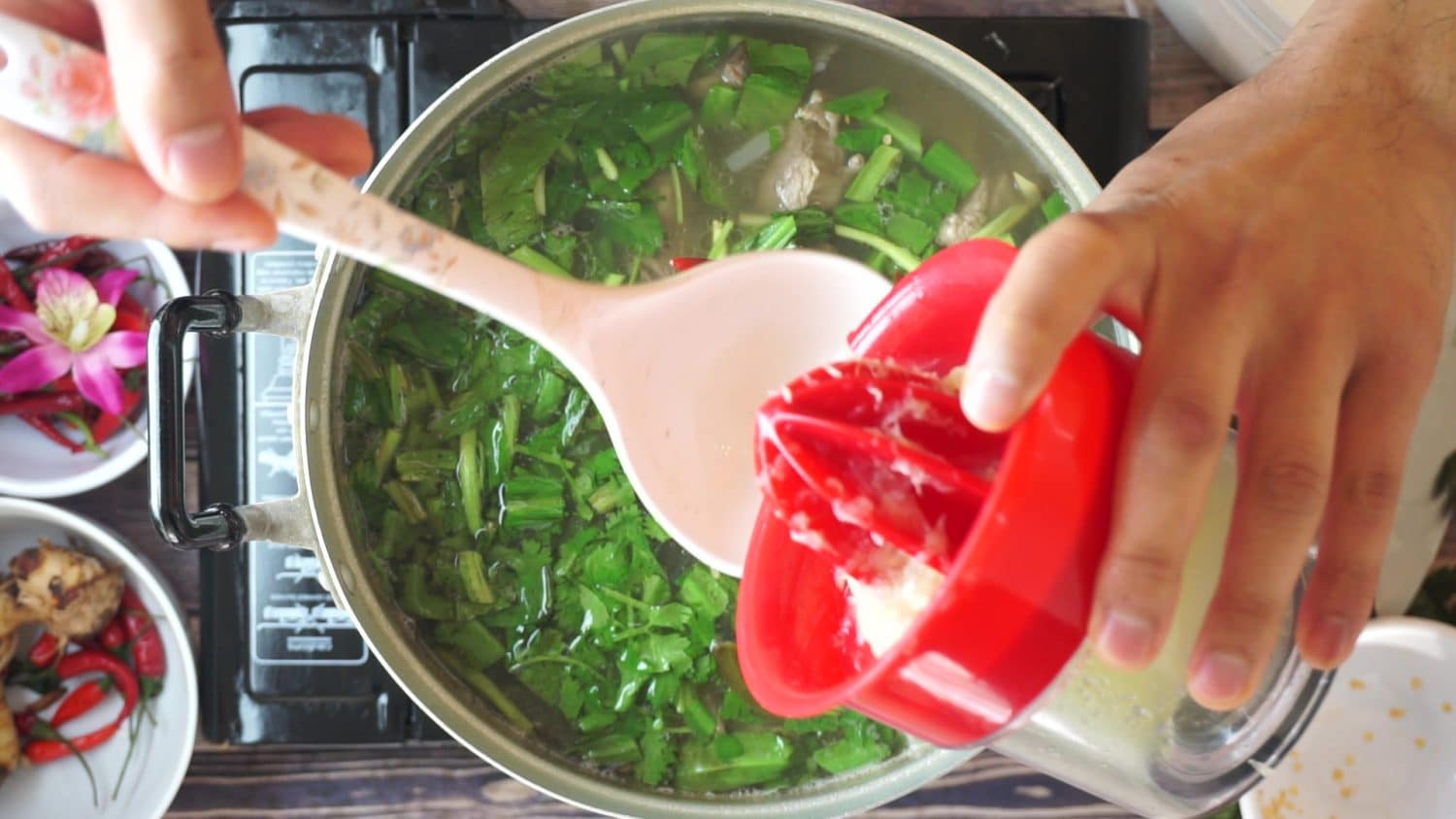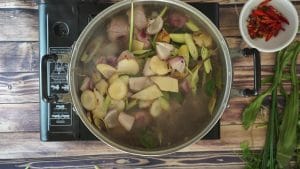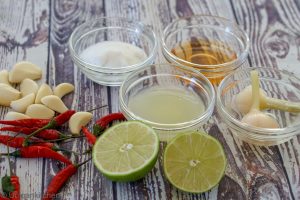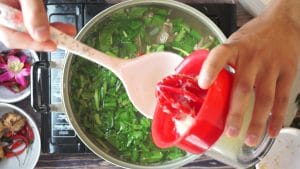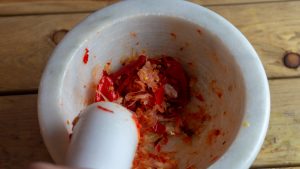How many times have you been disappointed following recipes from blogs, YouTube channels, cookbooks or Food TV shows? Of course, there’s nothing wrong with each recipe over the world if you don’t go blind seasoning exactly as they say.
It is the worst thing when we’ve prepared and cooked; then when it comes to seasoning, I mess it all up.
I’m always sad when Amy is looking at me with a frightened face and telling me, “Guide, this is too salty.”
In 2007, I started learning how to cook. I first learned Tom Yum, Thai famous spicy-sour soup, which I thought it was the easiest thing I could ever cook without a recipe, but it turned out to be the hardest dish I was able to season.
Tom Yum is a Thai herbal soup contains 3-knight herbs, lemongrass, galangal, and kaffir lime leaves. The soup texture is runny like water, unlike Western soups which are thicker.
I used chicken stock boiling with lemongrass, galangal, kiffir lime leaves till aroma( about ½ hours per a gallon) And then, I added shrimps while the broth is bubbling and followed by mushrooms, onions, tomatoes. Finally, I seasoned with fish sauce, sugar and lime juice.
It looked simple, but there were many factors to make my soup tasting too salty while it was supposed to be 3 tastes equivalent with sourness slightly leaded.
I thought cooking the soup was easy because the cooking method wasn’t complicating, but since it had 3+ tastes to balance in a single dish, it was challenging to season it now.
Today, let’s learn from my cooking experience on how to season food without following recipes especially Thai food in 3+ tastes.
The art of cooking
When you create a food, you’ll need 4 skills:
- Eat ( the ability to separate the flavors, telling deliciousness)–most people master this!
- Preparing ( the skill of cutting, slicing, chopping, dicing, peeling, etc.)–you know when you get cuts more than 4 times!
- Cooking ( the skill of making the ingredients to doneness hot or cold)–Learn A Quick Guide To 11 Methods Of Home-Cooking here)
- Seasoning ( skill to adjust the flavors)–Keep Reading.
Flavoring or seasoning is one of the art, and it’s not rocket science to master. Simply, you can practice by tasting frequently.
But, there are tricks and tips on how I develop all the recipes on my blog and, I would like to share with you to make your food yum to the roof.
Think about painting; you have a white canvas, 3 primary colors, and black. With these, you can build unlimited art paintings.
Same here with cooking—you have savoriness, salty, sweet, sour, and bitter as ordinary elements to create a countless meal.
Use these 7 steps respectively to develop your seasoning technique in Thai food or most food that has 3 or more flavors to balance
1. Find sources of “umami.”
Umami plays an important part as a “basic” of delicious food which can enhance overall taste and flavor to your dish. And you need to know where it remains from your ingredients.
You can find umami everywhere in vegetables, meats, herbs, seafood, oil, produces, grains, and on.
The ordinary item that refers the savoriness is Monosodium Glutamate or MSG which added in can goods, instant food and pre-made sauces.
According to the recent Health U.S.News, ‘Scientists Have Known MSG Is Safe for Decades. Why Don’t Most Americans?”, MSG doesn’t have a significant effect on a health issue, though it has been researched many times in the past.
However, if you don’t want extra MSG, you can create your umami by using these as examples:
- Stock broth: bone stock, meat stock, shrimp stock
- Herbs: garlic, fresh chili, basil, ginger, lemongrass, galangal, Kiffr lime.
- Spices: cinnamon, peppercorns, anise seeds.
- Fermented sauce: fish sauce, soybean sauce, ketchup.
- Some vegetables: celery, napa cabbage, lettuce, onions, daikon.
2. Choose which taste is distinctive
When a dish is bland means, you don’t design which flavor is outstanding. Pick one out of the four: salty, sweet, sour or bitter.
And then, create the rest around it.
For the example of creamy Tom Yum Prawns, I’ve planned to point the sourness is distinctive, then I make umami which is an herbal stock which has little bitterness to it, saltiness after and lightly sweetness(both from the prawns and small amount sugar added).
When tasting it, you should note the sourness at the first sip, but it will be weird sour if you don’t balance out the saltiness and the rest tastes around it.
3. Know your ingredients
It is a big mistake that I don’t understand how my ingredients taste. This will be the main reason why the recipe you got from another corner of the world sucks.
Fish sauce from different brands has different flavor and saltiness as well as soy sauce, seasoning sauce, oyster sauce. These brands have a range of quality. From my experience, the higher price is more likely to contain better quality.
Also, produce can taste different from different places around the world. A squeeze of lime from a blog may be sourer than where you get it.
4. Add a small amount
It’s a good idea to try out your ingredients by adding a bit at a time. After you sample all the ingredients, you might not be sure to combine everything. So, try a half portion from the recipe and make it up to a point.
When I develop a recipe, I gather all ingredients and sample to see how strong the flavor is, then try to add as less as possible. After I feel comfortable to add more, I go ahead and mix it up to the ceiling.
5. Fill Sour Taste Last
When my mom hands me a lime juice when seasoning a pot of Tom Yum soup, she always says putting it last.
Sourness in Thai food is mostly from lime juice, tamarind puree or paste, white vinegar, and fermented tofu. With these, you can create a sour freshness to enjoy during the summer heat.
If you use sour ingredients to cook too long, you’ll lose the sourness continuously and leave out only the bitter touch.
6. Always refresh your tongue before tasting
Food that has a strong flavor can confuse your taste buds easily.
When you eat a sweet shortcake(oh~yum), your taste bud receptors detect the sucrose and send the signal to your brain saying it’s sweet.
If you consume something less sweet than the cake immediately after for example drink a cup of dark cocoa, the brain won’t recognize that sweetness of the cocoa because the signal has already sent from the cake.
That’s why you lose control if you taste after taste and you end up you’ve added the taste too much.
To avoid this mistake, you should taste and clean your mouth with the room or warm temperature water to reset the taste bud receptor and send the default signal.
Pour a cup of water into your mouth and gargle to make sure every taste buds get reset, then rinse.
7. Avoid mixing too spicy when tasting
The last tip is simple for who doesn’t eat spicy food. Spiciness can cause burn to your tongue, and you’ll get numb from the reaction.
Capsaicin is a chemical Capsicum. It is an irritant for mammals, including humans, and produces a sensation of burning in any tissue with which it comes into contact. I avoid adding spices if possible when tasting.
However, some Thai food such as curries, stir-fried hot Thai basil, peanut sauce can’t cut down the hot as it’s the main ingredient we need to put first.
Conclusion
I’d refer how to make Creamy Tom Yum Angry Prawns. I’ve been making this soup 20+ times since 2007, and I’ve searched and dug out recipes from a Youtuber, my secret cookbook, and a Thai blog. Finally, I stop looking for it and start practicing by myself.
Making soup is easy to fix if something goes wrong, unlike stir-fried, slow-cooked, baking or any other methods. So, I think this is a good start practicing balancing out tastes in Thai food.
I wish the 7 steps can guide you to season Thai food to meet your expectation. If there’re any other tips and techniques you would like to share; please comment below.
Happy Seasoning!
References:
https://en.wikipedia.org/wiki/Capsaicin
https://th.wikipedia.org/wiki/การรับรู้รส

